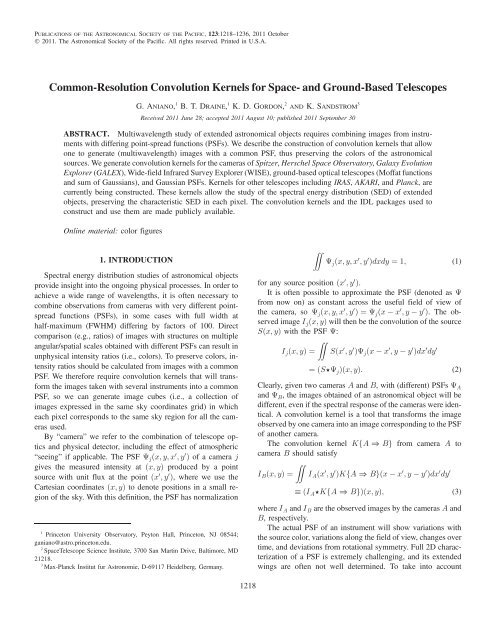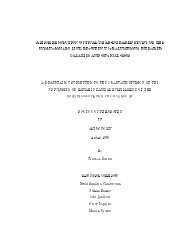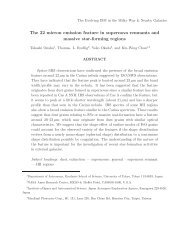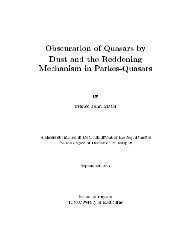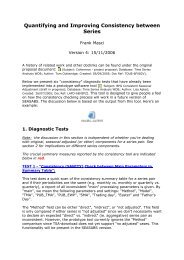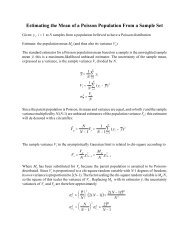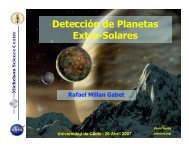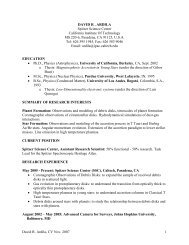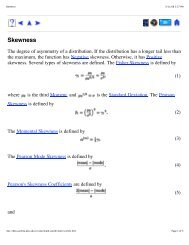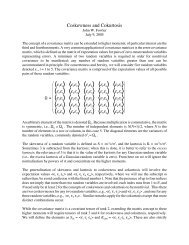Common-Resolution Convolution Kernels for Space- and ... - Caltech
Common-Resolution Convolution Kernels for Space- and ... - Caltech
Common-Resolution Convolution Kernels for Space- and ... - Caltech
Create successful ePaper yourself
Turn your PDF publications into a flip-book with our unique Google optimized e-Paper software.
PUBLICATIONS OF THE ASTRONOMICAL SOCIETY OF THE PACIFIC, 123:1218–1236, 2011 October<br />
© 2011. The Astronomical Society of the Pacific. All rights reserved. Printed in U.S.A.<br />
<strong>Common</strong>-<strong>Resolution</strong> <strong>Convolution</strong> <strong>Kernels</strong> <strong>for</strong> <strong>Space</strong>- <strong>and</strong> Ground-Based Telescopes<br />
G. ANIANO, 1 B. T. DRAINE, 1 K. D. GORDON, 2 AND K. SANDSTROM 3<br />
Received 2011 June 28; accepted 2011 August 10; published 2011 September 30<br />
ABSTRACT. Multiwavelength study of extended astronomical objects requires combining images from instruments<br />
with differing point-spread functions (PSFs). We describe the construction of convolution kernels that allow<br />
one to generate (multiwavelength) images with a common PSF, thus preserving the colors of the astronomical<br />
sources. We generate convolution kernels <strong>for</strong> the cameras of Spitzer, Herschel <strong>Space</strong> Observatory, Galaxy Evolution<br />
Explorer (GALEX), Wide-field Infrared Survey Explorer (WISE), ground-based optical telescopes (Moffat functions<br />
<strong>and</strong> sum of Gaussians), <strong>and</strong> Gaussian PSFs. <strong>Kernels</strong> <strong>for</strong> other telescopes including IRAS, AKARI, <strong>and</strong> Planck, are<br />
currently being constructed. These kernels allow the study of the spectral energy distribution (SED) of extended<br />
objects, preserving the characteristic SED in each pixel. The convolution kernels <strong>and</strong> the IDL packages used to<br />
construct <strong>and</strong> use them are made publicly available.<br />
Online material: color figures<br />
1. INTRODUCTION<br />
Spectral energy distribution studies of astronomical objects<br />
provide insight into the ongoing physical processes. In order to<br />
achieve a wide range of wavelengths, it is often necessary to<br />
combine observations from cameras with very different pointspread<br />
functions (PSFs), in some cases with full width at<br />
half-maximum (FWHM) differing by factors of 100. Direct<br />
comparison (e.g., ratios) of images with structures on multiple<br />
angular/spatial scales obtained with different PSFs can result in<br />
unphysical intensity ratios (i.e., colors). To preserve colors, intensity<br />
ratios should be calculated from images with a common<br />
PSF. We there<strong>for</strong>e require convolution kernels that will trans<strong>for</strong>m<br />
the images taken with several instruments into a common<br />
PSF, so we can generate image cubes (i.e., a collection of<br />
images expressed in the same sky coordinates grid) in which<br />
each pixel corresponds to the same sky region <strong>for</strong> all the cameras<br />
used.<br />
By “camera” we refer to the combination of telescope optics<br />
<strong>and</strong> physical detector, including the effect of atmospheric<br />
“seeing” if applicable. The PSF Ψ j ðx; y; x 0 ;y 0 Þ of a camera j<br />
gives the measured intensity at ðx; yÞ produced by a point<br />
source with unit flux at the point ðx 0 ;y 0 Þ, where we use the<br />
Cartesian coordinates ðx; yÞ to denote positions in a small region<br />
of the sky. With this definition, the PSF has normalization<br />
1<br />
Princeton University Observatory, Peyton Hall, Princeton, NJ 08544;<br />
ganiano@astro.princeton.edu.<br />
2<br />
<strong>Space</strong>Telescope Science Institute, 3700 San Martin Drive, Baltimore, MD<br />
21218.<br />
3<br />
Max-Planck Institut fur Astronomie, D-69117 Heidelberg, Germany.<br />
ZZ<br />
Ψ j ðx; y; x 0 ;y 0 Þdxdy ¼ 1; (1)<br />
<strong>for</strong> any source position ðx 0 ;y 0 Þ.<br />
It is often possible to approximate the PSF (denoted as Ψ<br />
from now on) as constant across the useful field of view of<br />
the camera, so Ψ j ðx; y; x 0 ;y 0 Þ¼Ψ j ðx x 0 ;y y 0 Þ. The observed<br />
image I j ðx; yÞ will then be the convolution of the source<br />
Sðx; yÞ with the PSF Ψ:<br />
ZZ<br />
I j ðx; yÞ ¼ Sðx 0 ;y 0 ÞΨ j ðx x 0 ;y y 0 Þdx 0 dy 0<br />
¼ðS⋆Ψ j Þðx; yÞ: (2)<br />
Clearly, given two cameras A <strong>and</strong> B, with (different) PSFs Ψ A<br />
<strong>and</strong> Ψ B , the images obtained of an astronomical object will be<br />
different, even if the spectral response of the cameras were identical.<br />
A convolution kernel is a tool that trans<strong>for</strong>ms the image<br />
observed by one camera into an image corresponding to the PSF<br />
of another camera.<br />
The convolution kernel KfA ⇒ Bg from camera A to<br />
camera B should satisfy<br />
ZZ<br />
I B ðx; yÞ ¼ I A ðx 0 ;y 0 ÞKfA ⇒ Bgðx x 0 ;y y 0 Þdx 0 dy 0<br />
≡ ðI A ⋆KfA ⇒ BgÞðx; yÞ; (3)<br />
where I A <strong>and</strong> I B are the observed images by the cameras A <strong>and</strong><br />
B, respectively.<br />
The actual PSF of an instrument will show variations with<br />
the source color, variations along the field of view, changes over<br />
time, <strong>and</strong> deviations from rotational symmetry. Full 2D characterization<br />
of a PSF is extremely challenging, <strong>and</strong> its extended<br />
wings are often not well determined. To take into account<br />
1218
COMMON-RESOLUTION CONVOLUTION KERNELS 1219<br />
deviations of PSFs from rotational symmetry would require separate<br />
kernels KfA ⇒ BgðγÞ <strong>for</strong> each relative orientation γ of<br />
cameras A <strong>and</strong> B. In the present study, the actual PSFs are close<br />
enough of having rotational symmetry that such additional complication<br />
is not justified (see § 3 <strong>for</strong> a detailed study). The current<br />
work assumes that Ψ A <strong>and</strong> Ψ B can be approximated by<br />
rotationally symmetric functions.<br />
Using a different technique, Alard & Lupton (1998) presented<br />
a method <strong>for</strong> finding optimal kernels to convolve (to a common<br />
resolution) images of a sky region taken with a single camera under<br />
different seeing conditions. Using techniques similar to those<br />
used here, Gordon et al. (2008) created kernels <strong>for</strong> the Infrared<br />
Array Camera (IRAC) <strong>and</strong> Multib<strong>and</strong> Imaging Photometer <strong>for</strong><br />
Spitzer (MIPS) cameras of Spitzer, <strong>and</strong> S<strong>and</strong>strom et al. (2009)<br />
created kernels <strong>for</strong> the Infrared Spectrograph (IRS) of Spitzer. In<br />
the present work, we use the latest characterization of the PSFs of<br />
the cameras on Spitzer (IRAC <strong>and</strong> MIPS), Herschel <strong>Space</strong><br />
Observatory (Photocamera Array Camera <strong>and</strong> Spectrometer<br />
<strong>for</strong> Herschel [PACS] <strong>and</strong> Spectral <strong>and</strong> Photometric Imaging<br />
Receiver <strong>for</strong> Herschel [SPIRE]), Galaxy Evolution Explorer<br />
(GALEX) (FUV, NUV), <strong>and</strong> the Wide-field Infrared Survey Explorer<br />
(WISE) (W1–W4). Additional PSFs (including those<br />
characterizing the IRS spectrograph on board Spitzer; the PACS<br />
spectrographs on board the Herschel <strong>Space</strong> Observatory; <strong>and</strong> allsky<br />
images produced by IRAS, AKARI, <strong>and</strong> Planck) are currently<br />
being constructed <strong>and</strong> will be added to the kernel library. We also<br />
include a family of analytical PSF profiles that are commonly<br />
used to model the PSFs <strong>for</strong> ground-based telescopes. We construct<br />
the set of kernels to trans<strong>for</strong>m from different instrumental<br />
PSFs into Gaussian PSFs, another <strong>for</strong>m that is widely used. We<br />
find an optimal Gaussian PSF <strong>for</strong> each camera: i.e., a Gaussian<br />
PSF that is sharp enough to capture the angular resolution of the<br />
camera <strong>and</strong> wide enough to be robust against image artifacts.<br />
Additional image processing (i.e., co-adding images 4 ) or different<br />
data reduction schemes (i.e., the Scanamorphos pipeline<br />
[Roussel 2011] <strong>for</strong> the Herschel images) will alter the PSF, <strong>and</strong><br />
thus new kernels should be constructed using the effective PSF.<br />
This article is organized as follows. In § 2 we describe the<br />
generation of convolution kernels, in § 3 we describe the PSF<br />
used, <strong>and</strong> in § 4 we describe the kernel construction strategy.<br />
The per<strong>for</strong>mance of the kernels is examined in § 5, <strong>and</strong> in § 6 we<br />
describe a set of Gaussian kernels that are compatible with the<br />
different instruments. In § 7 we describe the kernel usage <strong>and</strong><br />
show their per<strong>for</strong>mance on NGC 1097, <strong>and</strong> we summarize in § 8.<br />
All the kernels, IDL routines to use the kernels, <strong>and</strong> IDL routines<br />
to make new kernels, along with detailed analysis of the<br />
generated kernels, are publicly available. 5<br />
2. CONVOLUTION KERNELS<br />
Given two cameras A <strong>and</strong> B, with PSFs Ψ A <strong>and</strong> Ψ B , we seek<br />
KfA ⇒ Bg that fulfills equation (3) <strong>for</strong> any astronomical<br />
source. Thus,<br />
ðS⋆Ψ B Þ¼I B ¼ðI A ⋆KfA ⇒ BgÞ ¼ ðS⋆Ψ A ⋆KfA ⇒ BgÞ<br />
(4)<br />
<strong>for</strong> any astronomical source S, so the convolution kernel must<br />
satisfy<br />
Ψ B ¼ðΨ A ⋆KfA ⇒ BgÞ: (5)<br />
With the normalization condition given by equation (1), the<br />
kernel must have<br />
ZZ<br />
KfA ⇒ Bgðx; yÞdxdy ¼ 1: (6)<br />
We can easily invert equation (5) in Fourier space; taking the<br />
two-dimensional Fourier trans<strong>for</strong>m (FT) of equation (5) 6 we<br />
obtain<br />
FTðΨ B Þ¼FTðΨ A ⋆KfA ⇒ BgÞ<br />
This can be inverted to obtain<br />
¼ FTðΨ A Þ × FTðKfA ⇒ BgÞ: (7)<br />
<br />
KfA ⇒ Bg ¼FT<br />
FTðΨ 1 1<br />
B Þ × ; (8)<br />
FTðΨ A Þ<br />
where FT <strong>and</strong> FT 1 st<strong>and</strong> <strong>for</strong> the Fourier trans<strong>for</strong>m <strong>and</strong> its<br />
inverse trans<strong>for</strong>mation, respectively.<br />
Equation (8) provides a condition <strong>for</strong> the existence of such a<br />
kernel <strong>and</strong> a practical way of computing it. We can see that a<br />
condition <strong>for</strong> the existence of a kernel is that the Fourier components<br />
<strong>for</strong> which FTðΨ A Þ¼0 should satisfy FTðΨ B Þ¼0.<br />
In<strong>for</strong>mally speaking, this means that the PSF of camera A must<br />
be narrower than the PSF of camera B.<br />
For each camera A, we identify a high-frequency cutoff k H;A<br />
as the highest spatial frequency <strong>for</strong> which FTðΨ A Þ is appreciable<br />
by setting<br />
FTðΨ A Þðk H;A Þ¼5 × 10 3 × max½FTðΨ A ÞŠ: (9)<br />
The cutoff frequency k H;A can be normalized as k H;A ¼<br />
κ A × 2π=FWHM A . The values of κ A are in the range of<br />
1.08–1.46 <strong>and</strong> are given in Table 1.<br />
4<br />
For example, <strong>for</strong> 2MASS co-added images the images undergo an additional<br />
smearing with a kernel whose size corresponds to a detector pixel.<br />
5<br />
See http://www.astro.princeton.edu/~draine/<strong>Kernels</strong>.html. <strong>Kernels</strong><strong>for</strong>additional<br />
cameras <strong>and</strong> updates will be included when new PSF characterizations become<br />
available.<br />
6<br />
Computing the two-dimensional Fourier trans<strong>for</strong>m of rotationally symmetric<br />
functions is mathematically equivalent to making a decomposition in the oneparameter<br />
family of Bessel functions. However, the existence of the fast Fourier<br />
trans<strong>for</strong>m (FFT) algorithm makes it numerically more efficient to per<strong>for</strong>m the<br />
decomposition in the family of Fourier modes.<br />
2011 PASP, 123:1218–1236
1220 ANIANO ET AL.<br />
Camera<br />
Rayleigh diff. limit a<br />
(")<br />
TABLE 1<br />
BASIC INSTRUMENT INFORMATION<br />
Measured FWHM<br />
(")<br />
99% of energy radius Asymmetry<br />
(") κ b g c<br />
IRAC 3.6 μm ....... 1.04 1.90 62.52 1.29 0.16<br />
IRAC 4.5 μm ....... 1.31 1.81 64.46 1.26 0.17<br />
IRAC 5.8 μm ....... 1.68 2.11 133.55 1.20 0.19<br />
IRAC 8.0 μm ....... 2.30 2.82 114.20 1.19 0.18<br />
MIPS 24 μm ........ 6.93 6.43 224.53 1.05 0.08<br />
MIPS 70 μm ........ 20.90 18.74 461.44 1.12 0.05<br />
MIPS 160 μm ....... 45.62 38.78 678.77 1.10 0.05<br />
PACS 70 μm ........ 5.11 5.67 249.81 1.23 0.20<br />
PACS 100 μm ....... 7.28 7.04 350.63 1.19 0.20<br />
PACS 160 μm ....... 11.70 11.18 417.36 1.21 0.20<br />
SPIRE 250 μm ...... 17.93 18.15 205.07 1.16 0.19<br />
SPIRE 350 μm ...... 25.16 24.88 192.47 1.15 0.18<br />
SPIRE 500 μm ...... 36.22 36.09 198.43 1.16 0.19<br />
GALEX FUV . ....... 0.08 4.48 50.28 1.26 0.07<br />
GALEX NUV . ....... 0.11 5.05 39.56 1.32 0.05<br />
WISE 3.35 μm ...... 2.11 5.79 19.10 1.20 0.17<br />
WISE 4.60 μm ...... 2.89 6.37 19.08 1.33 0.13<br />
WISE 11.56 μm ..... 7.27 6.60 19.56 1.23 0.12<br />
WISE 22.1 μm ...... 13.90 11.89 35.15 1.05 0.07<br />
Gauss 12″ ........... … 12.00 15.41 1.33 0.0<br />
Gauss 20″ ........... … 20.00 25.68 1.33 0.0<br />
Gauss 23″ ........... … 23.00 29.53 1.33 0.0<br />
Gauss 28″ ........... … 28.00 35.95 1.33 0.0<br />
Gauss 40″ ........... … 40.00 51.33 1.33 0.0<br />
Gauss 50″ ........... … 50.00 64.05 1.33 0.0<br />
BiGauss 0.5″ ........ … 0.50 0.90 1.37 0.0<br />
BiGauss 1.0″ ........ … 1.00 1.79 1.37 0.0<br />
BiGauss 1.5″ ........ … 1.50 2.69 1.37 0.0<br />
BiGauss 2.0″ ........ … 2.00 3.57 1.37 0.0<br />
BiGauss 2.5″ ........ … 2.50 4.44 1.37 0.0<br />
Moffat 0.5″ .......... … 0.50 1.39 1.46 0.0<br />
Moffat 1.0″ .......... … 1.00 2.77 1.46 0.0<br />
Moffat 1.5″ .......... … 1.50 4.12 1.46 0.0<br />
Moffat 2.0″ .......... … 2.00 5.45 1.46 0.0<br />
Moffat 2.5″ .......... … 2.50 6.74 1.46 0.0<br />
a<br />
We take the Rayleigh diffraction limit as 1:22 × ½centralλŠ=½telescope diameterŠ.<br />
b<br />
We define κ as ðk H × FWHM A Þ=ð2πÞ, where k H is the high-frequency cutoff (see text <strong>for</strong> details).<br />
c<br />
The parameter g is a measure of the departure of a PSF from rotational symmetry (see eq. [12]).<br />
Equation (8) also provides insight of a possible problem<br />
in computing kernels. PSF Fourier trans<strong>for</strong>ms do not have<br />
significant power at (spatial) frequencies above the 2π=FWHM.<br />
The high-frequency components of the FT will be small, introducing<br />
large uncertainties when inverted.<br />
A possible way of avoiding problems in the high-frequency<br />
components of the kernel is to introduce a filter f A in the kernel<br />
construction:<br />
<br />
KfA ⇒ Bg ¼FT<br />
FTðΨ 1 1<br />
B Þ ×<br />
FTðΨ A Þ × f A ; (10)<br />
where f A is a suitable low-pass filter. Because this differs from<br />
equation (8), it is clear that a kernel satisfying equation (10)<br />
will, in general, not be an exact solution to equation (8).<br />
However, we can expect that if the filter f A does not remove significant<br />
power from the high-frequency components of either<br />
FTðΨ A Þ or FTðΨ B Þ, then the kernel computed will be a good<br />
approximate solution to equation (8).<br />
We use a filter f A of the <strong>for</strong>m<br />
8<br />
1<br />
><<br />
<br />
<strong>for</strong> k ≤ k L;A<br />
f A ðkÞ ¼<br />
1<br />
2<br />
1<br />
>:<br />
× þ cos π × k k L;A<br />
k H;A k L;A<br />
<strong>for</strong> k L;A ≤ k ≤ k H;A ;<br />
0 <strong>for</strong> k H;A ≤ k<br />
(11)<br />
where we set k L;A ¼ 0:7 × k H;A . Note that the cutoff frequency<br />
of our filter f A depends only on camera A, since small values of<br />
FTðΨ B Þ have no negative impact in the kernel construction. In<br />
2011 PASP, 123:1218–1236
COMMON-RESOLUTION CONVOLUTION KERNELS 1221<br />
principle, any smoothly varying function that is close to 1 in the<br />
low-frequency range <strong>and</strong> goes to zero in frequencies larger than<br />
k H;A should work as well. We have experimented using several<br />
smoothing functions <strong>and</strong> find that the particular <strong>for</strong>m of f A ðkÞ<br />
given by equation (11), with these particular choices of k L;A <strong>and</strong><br />
k H;A , gives excellent results. More details of the smoothing<br />
function effects can be found in § 5.<br />
If the cutoff frequencies associated with cameras A <strong>and</strong> B<br />
are such that k H;B ≤ k H;A × 0:7, then the filter f A has little effect<br />
<strong>and</strong> the resulting kernel from equation (10) will satisfy<br />
equation (3) to a very good approximation. In the regime k H;A ×<br />
0:7 ≤ k H;B ≤ k H;A the kernel KfA ⇒ Bg will depend on the<br />
exact <strong>for</strong>m of the filter f A used. Most of the kernels in this<br />
regime have good per<strong>for</strong>mance; the per<strong>for</strong>mance of such<br />
“filtered” kernels will be evaluated in § 5. A limiting case is<br />
a kernel KfA ⇒ Ag that trans<strong>for</strong>ms a PSF into itself; it is<br />
the Fourier trans<strong>for</strong>m of the filter f A .<br />
In the cases of k H;A
1222 ANIANO ET AL.<br />
FIG. 1.—PSF radial profiles <strong>for</strong> the 20 cameras considered here (see text). All PSFs are shown out to ΨðθÞ ≈ 10 5 Ψð0Þ, with the exception of WISE (W1–W4), <strong>for</strong><br />
which we have data only down to ≈0:002Ψð0Þ. See the electronic edition of the PASP <strong>for</strong> a color version of this figure.<br />
2011 PASP, 123:1218–1236
COMMON-RESOLUTION CONVOLUTION KERNELS 1223<br />
FIG. 2.—Fraction of the power enclosed by a circle of radius θ <strong>for</strong> the 20 cameras considered (see text). See the electronic edition of the PASP <strong>for</strong> a color version of this<br />
figure.<br />
2011 PASP, 123:1218–1236
1224 ANIANO ET AL.<br />
TABLE 2<br />
ENCLOSED ENERGY PERCENT (%) IN SELECTED CIRCULAR APERTURES<br />
Radii<br />
(")<br />
Camera 2.5 5 7.5 10 12.5 15 17.5 20 25 30 40 50 60 90 120<br />
IRAC 3.6 μm ........ 80.7 88.7 91.8 93.6 94.8 95.7 96.3 96.7 97.2 97.6 98.2 98.6 98.9 99.5 99.8<br />
IRAC 4.5 μm ........ 78.1 86.7 90.3 92.5 94.0 95.1 95.9 96.5 97.1 97.5 98.1 98.6 98.9 99.5 99.8<br />
IRAC 5.8 μm ........ 57.6 70.5 74.2 76.0 77.6 79.2 81.2 82.9 85.4 87.0 89.5 91.7 93.2 96.3 98.3<br />
IRAC 8.0 μm ........ 53.9 78.0 80.8 84.0 85.9 87.6 89.3 90.5 92.3 93.5 95.1 96.2 96.9 98.3 99.2<br />
MIPS 24 μm ......... 21.6 50.5 59.4 69.1 81.2 85.5 86.5 87.2 88.3 90.4 92.7 94.0 95.0 96.7 97.8<br />
MIPS 70 μm ......... 3.00 11.2 22.5 34.2 44.3 51.5 56.1 59.1 64.4 71.8 83.9 87.1 88.0 91.3 93.4<br />
MIPS 160 μm ....... 0.73 2.88 6.32 10.8 16.1 21.8 27.8 33.5 43.8 51.3 58.9 63.4 70.4 86.9 88.7<br />
PACS 70 μm ......... 26.8 56.8 69.3 76.6 80.0 82.2 84.1 85.6 87.3 88.6 90.4 91.8 92.9 95.3 96.7<br />
PACS 100 μm ....... 20.4 51.3 65.0 71.8 77.6 80.8 82.5 83.7 86.2 87.7 89.5 90.8 91.9 94.2 95.6<br />
PACS 160 μm ....... 8.89 29.3 49.0 61.2 67.8 72.3 76.2 79.3 82.8 84.7 87.6 89.5 90.8 93.1 94.5<br />
SPIRE 250 μm ...... 4.39 16.3 32.4 48.9 62.6 71.8 77.0 79.5 82.2 85.9 91.0 92.5 94.0 96.5 97.5<br />
SPIRE 350 μm ...... 2.48 9.56 20.1 32.7 45.6 57.2 66.9 73.9 81.2 83.5 87.8 92.5 94.0 96.6 97.9<br />
SPIRE 500 μm ...... 1.17 4.62 10.1 17.2 25.5 34.3 43.2 51.7 66.0 75.8 83.9 86.5 89.9 95.2 97.1<br />
GALEX FUV . . . . ..... 50.2 84.9 90.5 92.2 93.2 94.0 94.6 95.2 96.2 97.0 98.2 99.0 99.5 100 100<br />
GALEX NUV . . . ..... 40.7 79.3 88.1 90.5 91.9 93.0 93.9 94.7 96.1 97.2 99.1 99.8 99.9 100 100<br />
WISE 3.35 μm ....... 34.5 74.8 87.7 92.6 95.0 96.9 98.2 99.4 100 100 100 100 100 100 100<br />
WISE 4.60 μm ....... 28.4 68.0 85.9 91.5 94.4 96.7 98.2 99.4 100 100 100 100 100 100 100<br />
WISE 11.56 μm ..... 18.6 46.1 64.0 78.9 89.1 94.8 97.5 99.3 100 100 100 100 100 100 100<br />
WISE 22.1 μm ....... 7.36 24.9 42.8 54.3 60.4 66.0 74.0 83.1 94.5 97.6 99.7 100 100 100 100<br />
Gauss 12″ ............ 11.3 38.2 66.2 85.5 95.1 98.7 99.8 100 100 100 100 100 100 100 100<br />
Gauss 20″ ............ 4.24 15.9 32.3 50.0 66.2 79.0 88.1 93.8 98.7 99.8 100 100 100 100 100<br />
Gauss 23″ ............ 3.22 12.3 25.5 40.8 55.9 69.3 79.9 87.7 96.3 99.1 100 100 100 100 100<br />
Gauss 28″ ............ 2.18 8.46 18.0 29.8 42.5 54.9 66.2 75.7 89.1 95.9 99.7 100 100 100 100<br />
Gauss 40″ ............ 1.08 4.24 9.29 15.9 23.7 32.3 41.2 50.0 66.2 79.0 93.8 98.7 99.8 100 100<br />
Gauss 50″ ............ 0.69 2.73 6.05 10.5 15.9 22.1 28.8 35.8 50.0 63.2 83.1 93.8 98.2 100 100<br />
BiGauss 0.5″ . . . . ..... 100 100 100 100 100 100 100 100 100 100 100 100 100 100 100<br />
BiGauss 1.0″ ......... 99.9 100 100 100 100 100 100 100 100 100 100 100 100 100 100<br />
BiGauss 1.5″ ......... 98.6 100 100 100 100 100 100 100 100 100 100 100 100 100 100<br />
BiGauss 2.0″ ......... 95.7 99.9 100 100 100 100 100 100 100 100 100 100 100 100 100<br />
BiGauss 2.5″ ......... 89.9 99.5 100 100 100 100 100 100 100 100 100 100 100 100 100<br />
Moffat 0.5″ . .......... 100 100 100 100 100 100 100 100 100 100 100 100 100 100 100<br />
Moffat 1.0″ ........... 98.7 100 100 100 100 100 100 100 100 100 100 100 100 100 100<br />
Moffat 1.5″ ........... 96.1 99.5 100 100 100 100 100 100 100 100 100 100 100 100 100<br />
Moffat 2.0″ ........... 90.9 98.7 99.7 100 100 100 100 100 100 100 100 100 100 100 100<br />
Moffat 2.5″ ........... 83.0 97.7 99.3 99.8 100 100 100 100 100 100 100 100 100 100 100<br />
each analytical profile, we generate the kernels <strong>for</strong> a range of<br />
FWHM values. We consider the following analytical profiles:<br />
Gaussians.—We use a Gaussian PSF of the <strong>for</strong>m<br />
ΨðθÞ ¼ 1 θ<br />
2<br />
2πσ 2 exp 2σ 2 ; (13)<br />
p<br />
where the FWHM ¼ 2 × σ ffiffiffiffiffiffiffiffiffiffi<br />
2 ln 2. We generate kernels<br />
with 5″ < FWHM < 65″.<br />
Optical (SDSS).—In the SDSS survey, it is found that a good<br />
approximation to the telescope PSF is given by the sum of two<br />
Gaussians. The two components have relative weights of 0.9<br />
<strong>and</strong> 0.1, <strong>and</strong> the FWHM of the second component is twice that<br />
of the first. We use a family of PSFs of the <strong>for</strong>m<br />
ΨðθÞ ¼0:9 1 θ<br />
2<br />
2πσ 2 exp 2σ 2<br />
<br />
1<br />
θ<br />
2<br />
þ 0:1<br />
2πð2σÞ 2 exp 2ð2σÞ 2 :<br />
(14)<br />
p<br />
where the FWHM ¼ 1:01354 × 2 × σ<br />
ffiffiffiffiffiffiffiffiffiffi<br />
2 ln 2. We generate<br />
kernels with FWHM ¼ 0:5, 1.0, 1.5, 2.0, <strong>and</strong> 2.5″.<br />
Optical (General).—Moffat (1969) proposed PSFs of the<br />
<strong>for</strong>m<br />
M β ðθÞ ¼ ðβ <br />
1Þð21=β 1Þ<br />
r 2<br />
β;<br />
πθ 2 1 þð2 1Þ 1=β (15)<br />
0<br />
θ 0<br />
where β is a parameter, <strong>and</strong> FWHM ¼ 2θ 0 , Following Racine<br />
(1996) we use PSFs of the <strong>for</strong>m<br />
ΨðrÞ ¼0:8 × M 7 ðθÞþ0:2 × M 2 ðθÞ; (16)<br />
2011 PASP, 123:1218–1236
COMMON-RESOLUTION CONVOLUTION KERNELS 1225<br />
TABLE 3<br />
RADII (") ENCLOSING SELECTED PERCENTS OF TOTAL POWER<br />
Percent<br />
(%)<br />
Camera 25 50 65 80 90 95 98 99 99.5 99.9<br />
IRAC 3.6 μm ....... 0.74 1.19 1.60 2.44 5.83 12.9 36.0 62.5 88.1 132<br />
IRAC 4.5 μm ....... 0.75 1.24 1.73 2.68 7.06 14.7 37.9 64.5 90.8 134<br />
IRAC 5.8 μm ....... 0.99 1.97 3.17 16.0 42.3 75.3 114 134 145 154<br />
IRAC 8.0 μm ....... 1.16 2.21 3.32 6.70 18.9 39.5 82.9 114 134 152<br />
MIPS 24 μm ........ 2.73 4.93 9.18 12.2 29.4 60.4 130 225 368 738<br />
MIPS 70 μm ........ 8.02 14.4 25.5 35.6 80.2 158 318 461 628 894<br />
MIPS 160 μm ....... 16.3 29.0 52.8 71.9 155 287 518 679 802 950<br />
PACS 70 μm ........ 2.41 4.23 6.47 12.5 37.5 85.3 165 250 378 712<br />
PACS 100 μm ....... 2.83 4.87 7.50 14.1 43.5 105 227 351 477 711<br />
PACS 160 μm ....... 4.50 7.66 11.3 20.8 53.3 133 294 417 524 712<br />
SPIRE 250 μm ...... 6.39 10.2 13.1 20.8 36.6 66.1 138 205 382 488<br />
SPIRE 350 μm ...... 8.49 13.4 17.0 23.7 43.9 75.0 122 192 397 499<br />
SPIRE 500 μm ...... 12.4 19.5 24.6 33.5 60.3 85.9 137 198 411 511<br />
GALEX FUV ........ 1.59 2.49 3.17 4.27 7.05 19.0 38.3 50.3 59.7 75.1<br />
GALEX NUV ........ 1.82 2.90 3.71 5.08 9.34 20.9 33.9 39.6 43.4 58.7<br />
WISE 3.35 μm ...... 2.03 3.26 4.17 5.67 8.36 12.5 17.2 19.1 20.2 21.4<br />
WISE 4.60 μm ...... 2.29 3.69 4.75 6.36 9.00 13.0 17.2 19.1 20.2 21.4<br />
WISE 11.56 μm . . ... 3.02 5.48 7.66 10.2 12.8 15.1 18.1 19.6 20.5 21.5<br />
WISE 22.1 μm ...... 5.01 8.87 14.6 19.1 22.3 25.4 31.2 35.1 38.5 42.1<br />
Gauss 12″ ........... 3.86 6.00 7.38 9.14 10.9 12.5 14.2 15.4 16.5 18.5<br />
Gauss 20″ ........... 6.44 10.00 12.3 15.2 18.2 20.8 23.7 25.7 27.5 30.9<br />
Gauss 23″ ........... 7.41 11.5 14.1 17.5 20.9 23.9 27.3 29.5 31.6 35.5<br />
Gauss 28″ ........... 9.02 14.0 17.2 21.3 25.5 29.1 33.2 36.0 38.5 43.2<br />
Gauss 40″ ........... 12.9 20.0 24.6 30.5 36.4 41.5 47.4 51.3 54.9 61.5<br />
Gauss 50″ ........... 16.1 25.0 30.8 38.1 45.5 51.9 59.2 64.1 68.4 76.3<br />
BiGauss 0.5″ ........ 0.17 0.26 0.32 0.41 0.50 0.60 0.76 0.90 1.02 1.25<br />
BiGauss 1.0″ ........ 0.33 0.52 0.64 0.81 1.00 1.20 1.53 1.79 2.04 2.50<br />
BiGauss 1.5″ ........ 0.50 0.78 0.97 1.22 1.50 1.80 2.29 2.69 3.05 3.71<br />
BiGauss 2.0″ ........ 0.66 1.04 1.29 1.62 2.00 2.40 3.04 3.57 4.04 4.86<br />
BiGauss 2.5″ ........ 0.83 1.30 1.61 2.03 2.50 3.00 3.79 4.44 5.01 5.96<br />
Moffat 0.5″ .......... 0.18 0.29 0.36 0.47 0.60 0.76 1.07 1.39 1.72 2.26<br />
Moffat 1.0″ .......... 0.36 0.57 0.72 0.94 1.21 1.53 2.14 2.77 3.43 4.50<br />
Moffat 1.5″ .......... 0.54 0.86 1.08 1.41 1.81 2.29 3.19 4.12 5.09 6.70<br />
Moffat 2.0″ .......... 0.71 1.14 1.44 1.88 2.42 3.05 4.23 5.45 6.69 8.90<br />
Moffat 2.5″ .......... 0.89 1.43 1.81 2.34 3.02 3.80 5.27 6.74 8.29 11.1<br />
where the same θ 0 is used in M 7 <strong>and</strong> M 2 . We generate kernels<br />
with FWHM ¼ 2θ 0 ¼ 0:5, 1.0, 1.5, 2.0, <strong>and</strong> 2.5″.<br />
4. KERNEL GENERATION<br />
Generation of the convolution kernels was accomplished as<br />
follows.<br />
4.1. Input the PSF <strong>and</strong> Correct <strong>for</strong> Missing Data<br />
When an input PSF image has missing data pixels (like the<br />
current SPIRE PSFs), we iteratively estimate the missing values.<br />
We start by replacing the missing data pixels by a value<br />
of 0 in the original image. We compute a smoothed image<br />
by convolving it with a (normalized) Gaussian kernel<br />
∝ exp½ ðθ=2θ 0 Þ 2 Š, with θ 0 equal to 2 pixels. We replace the<br />
original image missing data pixels by the value they have in<br />
the convolved image (the original data are not altered). We iterate<br />
the convolution <strong>and</strong> replacement steps 5 times. The resulting<br />
image has all the missing data points replaced by a smooth<br />
interpolation. This technique produces robust results, even if<br />
we have missing data in a patch of a few contiguous pixels.<br />
4.2. Resample the PSFs<br />
Each PSF comes in a grid of different pixel size. We trans<strong>for</strong>m<br />
each PSF into a grid of a common pixel size of 0.20″ using<br />
the IDL procedure congrid, using the cubic convolution interpolation<br />
method with a parameter of 0:5. The 0.20″ pixel<br />
size captures all the details on the instrumental <strong>and</strong> Gaussian<br />
PSFs. We also pad with 0 the resulting images into an odd-sized<br />
square array if needed.<br />
We use a grid of a common pixel size of 0.10″ to regenerate<br />
the kernels from optical PSFs into IRAC cameras.<br />
2011 PASP, 123:1218–1236
1226 ANIANO ET AL.<br />
4.3. Center the PSFs<br />
To determine the image center, we smooth the image with a<br />
5 pixel radius circular kernel <strong>and</strong> locate the image maximum. In<br />
some PSFs the maximum value is achieved over a (small) ring.<br />
To avoid possible misidentification of the real image center, we<br />
take the centroid of all the pixels that satisfy<br />
max½ΨŠ Ψðx; yÞ<br />
≤ 5 × 10 4 : (17)<br />
max½ΨŠ<br />
4.4. Circularize the PSFs<br />
In order to make a rotationally symmetric PSF, we average<br />
over 2 14 rotations of the image through angles β n ¼ n×<br />
360°=2 14 <strong>for</strong> n ¼ 1; 2; 3; …; 2 14 ¼ 16; 384, producing a PSF<br />
image that is invariant under rotations of any angle that is a<br />
multiple of 360°=2 14 ¼ 0:022° (i.e., is as rotationally symmetric<br />
as we can numerically expect).<br />
Computing 2 14 rotations naively would be extremely timeconsuming,<br />
but the final result can in fact be computed per<strong>for</strong>ming<br />
only 14 rotations, as follows.<br />
We start by rotating Ψ by an angle θ 1 ¼ 360°=2 1 ¼ 180°,<br />
producing an image R 1 , <strong>and</strong> computing their average<br />
R 1 ¼ 1 2 × ½Ψ þ R 1Š. Clearly, R 1 is now invariant under rotations<br />
of θ 1 ¼ 360°=2 1 ¼ 180°.<br />
We continue this procedure iteratively. We rotate R 1 by an<br />
angle θ 2 ¼ 360°=2 2 ¼ 90°, producing an image R 2 , <strong>and</strong> set<br />
R 2 ¼ 1 2 × ½ R 1 þ R 2 Š. R 2 is invariant under rotations of θ 1 ¼<br />
360°=2 1 ¼ 180° <strong>and</strong> θ 2 ¼ 360°=2 2 ¼ 90°; i.e. it is invariant<br />
under rotations of any angle that is a multiple of 360°=2 2 ¼ 90°.<br />
We iterate this procedure 14 times; the last average calculated<br />
image R 14 is the desired rotationally symmetric PSF.<br />
We further set to 0 all the pixels that lie outside the largest<br />
circle included in the square image, since those regions would<br />
correspond to areas with partial image coverage. If there are pixels<br />
with (very small) negative values (due to the noise in the<br />
original PSFs) we set them to 0.<br />
In order to have a more stable algorithm, the previous<br />
rotations are per<strong>for</strong>med in reverse order (i.e., starting with the<br />
smallest angles).<br />
All the remaining steps in the kernel construction should preserve<br />
the rotational symmetry in the images. A way of estimating<br />
the noise induced by some steps (e.g., computing Fourier<br />
trans<strong>for</strong>m) is to compute the departure from rotational symmetry<br />
in the resulting image. Circularizing helps to reduce numerical<br />
noise <strong>and</strong> will be per<strong>for</strong>med after every step that can<br />
potentially decrease the image quality. When a circularization<br />
is per<strong>for</strong>med to a rotationally symmetric image, the asymmetry<br />
parameter g of the resulting image is smaller than 0.0008 (i.e.,<br />
the circularization procedure itself induces very small departures<br />
from rotational symmetry).<br />
4.5. Resize the PSFs<br />
We trim (or pad with 0) all the PSFs into a common grid, to<br />
be able to compute all the convolution kernels using only one<br />
Fourier trans<strong>for</strong>m per PSF. We choose a grid size that is large<br />
enough to contain most of the power in each PSF. We also optimize<br />
its size to make the FFT algorithm as efficient as possible<br />
(minimal sum of prime factors). The adopted grid size is<br />
729″ × 729″, giving an image size of 3645 × 3645 pixels.<br />
4.6. Compute the Fourier Trans<strong>for</strong>m of the PSF FTðΨÞ<br />
We use an efficient FFT algorithm. Since the PSFs are invariant<br />
under reflections, ~x↔ ~x, their Fourier trans<strong>for</strong>m should<br />
be real. We impose this real condition to reduce the numerical<br />
noise introduced by the double-precision FFT algorithm.<br />
4.7. Circularize the FTðΨÞ<br />
Using the procedure as be<strong>for</strong>e, we circularize the FTðΨÞ. In<br />
principle, they should already be rotationally symmetric, but<br />
numerical noise in the FFT algorithm makes them slightly nonrotationally<br />
symmetric.<br />
4.8. Filter the FTðΨÞ<br />
We filter the highest frequencies in each FTðΨÞ. We use a<br />
filter ϕ of the <strong>for</strong>m<br />
8<br />
1 >< <br />
<strong>for</strong> k ≤ k α<br />
4<br />
<br />
ϕðkÞ ¼ exp 1:8249 × k k α<br />
k β k α<br />
<strong>for</strong> k α ≤ k ≤ k β ;<br />
>:<br />
0 <strong>for</strong> k β ≤ k<br />
(18)<br />
where we set k α ¼ 0:9 × k β . The factor 1.8249 is chosen so<br />
that ϕð0:5 × ðk β þ k α ÞÞ ¼ 0:5. For each camera we choose<br />
k β ¼ 4 × ð2π=FWHMÞ. We tested several filter functions <strong>and</strong><br />
found that the particular <strong>for</strong>m given by equation (19) provided<br />
the best results. Each PSF has structure at spatial wavelengths<br />
comparable with the FWHM, so the Fourier components with<br />
frequencies much higher than this cannot be important. The<br />
Fourier components removed by this filter were mainly introduced<br />
by the original image resizing algorithm. In the following<br />
discussion, we let FT ϕ ðΨÞ ¼ϕ × FTðΨÞ.<br />
4.9. Invert the FTðΨÞ<br />
We evaluate 1=FT ϕ ðΨÞ at the points where FT ϕ ðΨÞ ≠ 0.We<br />
set 1=FT ϕ ðΨÞ ¼0 at the remaining points (which will be<br />
filtered soon).<br />
4.10. Compute the FT of the Filtered Kernel<br />
We compute the FT of the filtered kernel using the filter f A<br />
from equation (11):<br />
2011 PASP, 123:1218–1236
COMMON-RESOLUTION CONVOLUTION KERNELS 1227<br />
FIG. 3.—Per<strong>for</strong>mance of the filtered kernel KfM24 ⇒ S250g. W is the integral of the negative values of the kernel, <strong>and</strong> D is the integral of the absolute value of the<br />
difference between the target PSF <strong>and</strong> the PSF reproduced by the kernel (see eq. [20]). See the electronic edition of the PASP <strong>for</strong> a color version of this figure.<br />
f A<br />
FTðKfA ⇒ BgÞ ¼ FT ϕ ðΨ B Þ ×<br />
FT ϕ ðΨ A Þ<br />
<strong>for</strong> all the appropriate combinations ðA; BÞ.<br />
4.11. Compute the <strong>Kernels</strong><br />
(19)<br />
We compute the inverse Fourier trans<strong>for</strong>m to the previously<br />
calculated FTðKÞ. We again impose the condition that K must<br />
be real.<br />
4.12. Circularize the <strong>Kernels</strong><br />
Using the procedure as be<strong>for</strong>e, we circularize the kernels.<br />
Again, they should already be rotationally symmetric. Numerical<br />
noise in the inverse FFT algorithm makes them slightly<br />
asymmetric, but this is easily corrected.<br />
4.13. Resample the <strong>Kernels</strong><br />
All the computed kernels are given in a grid of a common<br />
pixel size of 0.20″, but will be needed in grids of different pixel<br />
sizes. Again, we resample the kernels using the IDL procedure<br />
congrid, using the cubic convolution interpolation method<br />
with a parameter of 0:5.<br />
4.14. Final Trim of the <strong>Kernels</strong><br />
We trim each kernel to a smaller size (to speed up further<br />
convolution) such that it contains 99.9% of the total kernel energy.<br />
Moreover, we use a square grid with an odd number of<br />
pixels so that the kernel peaks in a single central pixel.<br />
4.15. Circularize the Final <strong>Kernels</strong><br />
We finish the kernels by circularizing them again, to remove<br />
the small noise introduced in the resampling process. All previous<br />
calculations were done in double precision to reduce<br />
numerical noise.<br />
5. KERNEL PERFORMANCE<br />
For each generated kernel, we compute Ψ A ⋆KfA ⇒ Bg,<br />
the convolution of Ψ A <strong>and</strong> KfA ⇒ Bg, <strong>and</strong> compare it with<br />
Ψ B . 12 For a perfect kernel, both quantities should coincide at<br />
all radii.<br />
Figure 3 shows the analysis of KfM24 ⇒ S250g. 13 This<br />
kernel shows good behavior: it trans<strong>for</strong>ms from a camera with<br />
FWHM M24 ¼ 6:5″ into a camera with FWHM S250 ¼ 18:2″. This<br />
kernel essentially spreads the energy of the core of MIPS 24 μm<br />
into a larger area. The filter f M24 has no effect on the construction<br />
of this kernel, because FTðΨ B Þ ≈ 0 <strong>for</strong> k>0:7 × k H;A .<br />
The left panel of Figure 3 compares the integrated power of<br />
the PSFs. It includes Ψ M24 (dot-dashed line), Ψ S250 (solid line),<br />
<strong>and</strong> Ψ M24 ⋆KfM24 ⇒ S250g (dashed line). For an ideal kernel<br />
the solid line <strong>and</strong> the dashed line should coincide. The departures<br />
in this case are very small.<br />
12<br />
It can be easily shown that the radial profile of ðΨ A ⋆KfA ⇒ BgÞ is the<br />
same whether Ψ A is rotationally symmetric or not, so <strong>for</strong> simplicity, we use the<br />
circularized version of Ψ A in the comparison.<br />
13<br />
In our PSF <strong>and</strong> kernel notations, we will abbreviate IRAC, MIPS, PACS,<br />
SPIRE, GALEX, <strong>and</strong> WISE as I, M, P, S, GAL, <strong>and</strong> W, respectively, <strong>and</strong> will<br />
omit the μm symbol.<br />
2011 PASP, 123:1218–1236
1228 ANIANO ET AL.<br />
The power per unit radius is proportional to θΨðθÞ, or θKðθÞ.<br />
The right panel of Figure 3 shows θΨ <strong>and</strong> θK (normalized to the<br />
maximum value). The lower part of the right panel includes four<br />
traces: θ × Ψ M24 (dot-dashed line), θ × Ψ S250 (solid line), θ×<br />
ðΨ M24 ⋆KfM24 ⇒ S250gÞ (dashed line) <strong>and</strong> θ × KfM24 ⇒<br />
S250g (dotted line) <strong>for</strong> visualization of the kernel behavior.<br />
For an ideal kernel the solid line <strong>and</strong> the dashed line should<br />
coincide. The upper part of the right panel is a plot of the difference<br />
between θ × Ψ S250 <strong>and</strong> θ × ðΨ M24 ⋆KfM24 ⇒ S250gÞ.<br />
For an ideal kernel this graph should be 0. For this example<br />
(KfM24 ⇒ S250g), the Ψ M24 ⋆KfM24 ⇒ S250g reproduces<br />
the SPIRE 250 μm PSF to within 0:01 × Ψ S250 ð0Þ.<br />
In Figures 4 <strong>and</strong> 5 we analyze the kernels KfM70 ⇒ S250g<br />
<strong>and</strong> KfS250 ⇒ M70g. Their construction is more challenging<br />
since both cameras have similar FWHM: FWHM M70 ¼ 18:7″<br />
<strong>and</strong> FWHM S250 ¼ 18:2″. These kernels have to redistribute the<br />
energy within the core <strong>and</strong> Airy rings of the PSFs. The plotted<br />
quantities are similar to those in the right panel of Figure 3 <strong>for</strong><br />
KfM24 ⇒ S250g. In this case, the kernels still per<strong>for</strong>m well,<br />
but they have large areas with negative values.<br />
One measure of kernel per<strong>for</strong>mance is its accuracy in<br />
redistribution of PSF power. We define<br />
ZZ<br />
D ¼ jΨ B KfA ⇒ Bg⋆Ψ A jdxdy: (20)<br />
A kernel with perfect per<strong>for</strong>mance will have D ¼ 0, <strong>and</strong> normalization<br />
of the PSFs requires D ≤ 2. D measures how much<br />
flux has not been redistributed correctly. Good kernels have<br />
small D values: DðKfM24 ⇒ S250gÞ ¼ 0:011. In Table 4<br />
we give D <strong>for</strong> the kernels constructed.<br />
A second quantitative measure of kernel per<strong>for</strong>mance is<br />
obtained by studying its negative values. We define<br />
W ¼ 1 2<br />
ZZ<br />
ðjKfA ⇒ Bgj KfA ⇒ BgÞdxdy: (21)<br />
Flux conservation requires that W þ ¼ 1 þ W . In general,<br />
kernels will have W > 0. Well-behaved kernels have small<br />
W values: W ðKfM24 ⇒ SP250gÞ ¼ 0:07. The integral of<br />
jKfA ⇒ Bgj is ½1 þ 2W Š, so a kernel with a large value of<br />
W could potentially amplify image artifacts. Additionally, a<br />
kernel with large W can generate areas of negative flux near<br />
point sources if nonlinearities are present or if the background<br />
levels were subtracted incorrectly. Table 5 lists the W values<br />
<strong>for</strong> the kernels constructed. The values in Table 5 were computed<br />
numerically. Due to finite grid resolution the numerical<br />
values may be off by a few percent in some cases. This can be<br />
seen from the W values computed <strong>for</strong> the self-kernels. The<br />
self-kernels are simply the Fourier trans<strong>for</strong>m of the filter f A ,<br />
<strong>and</strong> W should there<strong>for</strong>e be the same (1.15) in all cases. However,<br />
in Table 5 the W <strong>for</strong> the smallest PSFs are larger than<br />
1.15 by as much as 0.03 (e.g., 1.18 <strong>for</strong> PACS 70 μm).<br />
Essentially, there are two sources of W : oscillations due to<br />
the filter f A <strong>and</strong> the need to remove energy from some region to<br />
relocate to another region (when the target Ψ B is narrower than<br />
Ψ A or has less energy in some annuli).<br />
The kernels between cameras with similar FWHM also have<br />
oscillations. Using a softer filter f A would reduce the oscillatory<br />
FIG. 4.—Per<strong>for</strong>mance of the kernel KfM70 ⇒ S250g. Because of the large<br />
value W ¼ 2:14, convolution MIPS70 μm ⇒ SPIRE250 μm is not recommended.<br />
See the electronic edition of the PASP <strong>for</strong> a color version of this figure.<br />
FIG. 5.—Per<strong>for</strong>mance of the kernel KfS250 ⇒ M70g. With W ¼ 0:61,<br />
this kernel is safe to use. Ψ S250 ⋆KfS250 ⇒ M70g deviates from Ψ M70 less than<br />
2%. See the electronic edition of the PASP <strong>for</strong> a color version of this figure.<br />
2011 PASP, 123:1218–1236
COMMON-RESOLUTION CONVOLUTION KERNELS 1229<br />
TABLE 4<br />
D VALUES FOR CONSTRUCTED KERNELS<br />
To<br />
From<br />
M<br />
24<br />
M<br />
70<br />
M<br />
160<br />
P<br />
70<br />
P<br />
100<br />
P<br />
160<br />
S<br />
250<br />
S<br />
350<br />
S<br />
500<br />
GAL<br />
NUV<br />
GAL<br />
NUV<br />
W<br />
3.4<br />
W<br />
4.6<br />
W<br />
11.6<br />
W<br />
22.1<br />
I3.6 .............. 0.065 0.029 0.037 0.051 0.047 0.031 0.025 0.022 0.018 0.006 0.005 0.005 0.005 0.007 0.008<br />
I4.5 .............. 0.065 0.029 0.037 0.051 0.047 0.031 0.025 0.022 0.018 0.006 0.005 0.005 0.005 0.007 0.008<br />
I5.8 .............. 0.064 0.031 0.048 0.047 0.045 0.031 0.029 0.027 0.018 0.012 0.010 0.012 0.012 0.013 0.012<br />
I8.0 .............. 0.064 0.030 0.047 0.047 0.046 0.032 0.026 0.024 0.018 0.012 0.007 0.007 0.007 0.009 0.009<br />
M24 . . ........... 0.091 0.018 0.048 0.213 0.068 0.015 0.011 0.013 0.017 NC 0.352 0.225 0.122 0.098 0.027<br />
M70 . . ........... NC 0.055 0.038 NC NC NC 0.102 0.015 0.014 NC NC NC NC NC NC<br />
M160 . ........... NC NC 0.064 NC NC NC NC NC 0.169 NC NC NC NC NC NC<br />
P70 . . . ........... 0.006 0.019 0.049 0.045 0.010 0.014 0.011 0.014 0.017 0.227 0.113 0.064 0.045 0.027 0.027<br />
P100 . . ........... 0.072 0.014 0.045 0.188 0.050 0.010 0.011 0.014 0.015 NC NC 0.202 0.111 0.087 0.028<br />
P160 . . ........... NC 0.009 0.040 NC NC 0.044 0.013 0.014 0.015 NC NC NC NC NC 0.032<br />
S250 . . ........... NC 0.037 0.045 NC NC NC 0.058 0.009 0.014 NC NC NC NC NC NC<br />
S350 . . ........... NC 0.300 0.043 NC NC NC NC 0.060 0.012 NC NC NC NC NC NC<br />
S500 . . ........... NC NC 0.042 NC NC NC NC NC 0.055 NC NC NC NC NC NC<br />
FUV . . ........... 0.065 0.030 0.036 0.049 0.046 0.032 0.025 0.024 0.018 0.046 0.017 0.007 0.006 0.007 0.007<br />
NUV . ........... 0.065 0.030 0.037 0.051 0.046 0.032 0.027 0.024 0.018 0.071 0.028 0.008 0.006 0.006 0.007<br />
W 3.4 ........... 0.066 0.029 0.037 0.080 0.048 0.032 0.026 0.023 0.018 0.252 0.122 0.053 0.034 0.017 0.007<br />
W 4.6 ........... 0.066 0.029 0.037 0.079 0.047 0.032 0.026 0.023 0.018 NC 0.118 0.051 0.033 0.016 0.006<br />
W 11.6 . . . . ...... 0.074 0.028 0.037 0.117 0.056 0.031 0.026 0.023 0.018 NC 0.206 0.109 0.063 0.040 0.005<br />
W 22.1 . . . . ...... NC 0.028 0.036 NC NC 0.163 0.028 0.023 0.018 NC NC NC NC NC 0.094<br />
NOTES.—D is the integral of the absolute value of the difference between a target PSF <strong>and</strong> the PSF reproduced by the kernel (see eq. [20]).<br />
We are abbreviating IRAC, MIPS, PACS, SPIRE, GALEX, <strong>and</strong> WISE as I, M, P, S, GAL, <strong>and</strong> W, respectively. NC st<strong>and</strong>s <strong>for</strong> not computed: the kernel<br />
per<strong>for</strong>mance would be too poor.<br />
2011 PASP, 123:1218–1236
1230 ANIANO ET AL.<br />
TABLE 5<br />
W VALUES FOR CONSTRUCTED KERNELS<br />
To<br />
From<br />
M<br />
24<br />
M<br />
70<br />
MI<br />
160<br />
P<br />
70<br />
P<br />
100<br />
P<br />
160<br />
S<br />
250<br />
S<br />
350<br />
S<br />
500<br />
GAL<br />
FUV<br />
GAL<br />
NUV<br />
W<br />
3.4<br />
W<br />
4.6<br />
W<br />
11.6<br />
W<br />
22.1<br />
I3.6 ...................... 0.00 0.00 0.00 0.00 0.00 0.00 0.00 0.00 0.00 0.06 0.03 0.05 0.05 0.05 0.02<br />
I4.5 ...................... 0.01 0.00 0.00 0.00 0.00 0.00 0.00 0.00 0.00 0.07 0.03 0.05 0.05 0.05 0.02<br />
I5.8 ...................... 0.15 0.03 0.02 0.07 0.07 0.03 0.05 0.05 0.02 0.29 0.23 0.25 0.24 0.23 0.15<br />
I8.0 ...................... 0.11 0.00 0.00 0.01 0.01 0.00 0.00 0.01 0.00 0.23 0.11 0.14 0.14 0.12 0.06<br />
M24 . . ................... 1.17 0.02 0.00 2.85 0.75 0.16 0.06 0.04 0.01 NC 5.14 3.28 1.83 1.11 0.32<br />
M70 . . ................... NC 1.15 0.20 NC NC NC 2.14 0.66 0.34 NC NC NC NC NC NC<br />
M160 . ................... NC NC 1.14 NC NC NC NC NC 2.81 NC NC NC NC NC NC<br />
P70 . . . ................... 0.83 0.01 0.01 1.18 0.32 0.00 0.05 0.05 0.02 5.74 2.68 1.48 0.77 0.48 0.16<br />
P100 . . ................... 2.16 0.01 0.01 4.29 1.17 0.04 0.07 0.06 0.03 NC NC 4.82 2.56 1.75 0.24<br />
P160 . . ................... NC 0.11 0.02 NC NC 1.16 0.24 0.14 0.06 NC NC NC NC NC 1.10<br />
S250 . . ................... NC 0.61 0.02 NC NC NC 1.15 0.21 0.06 NC NC NC NC NC NC<br />
S350 . . ................... NC 6.08 0.08 NC NC NC NC 1.15 0.14 NC NC NC NC NC NC<br />
S500 . . ................... NC NC 0.47 NC NC NC NC NC 1.14 NC NC NC NC NC NC<br />
FUV . . ................... 0.15 0.00 0.00 0.10 0.01 0.00 0.00 0.00 0.00 1.18 0.30 0.21 0.11 0.07 0.03<br />
NUV . . ................... 0.33 0.00 0.00 0.47 0.07 0.00 0.00 0.00 0.00 3.35 1.18 0.60 0.26 0.12 0.03<br />
W 3.4 . ................... 0.60 0.00 0.00 1.05 0.21 0.00 0.01 0.00 0.00 5.02 2.37 1.18 0.53 0.29 0.01<br />
W 4.6 . ................... 1.27 0.00 0.00 2.19 0.56 0.00 0.01 0.00 0.00 NC 4.29 2.43 1.18 0.83 0.04<br />
W 11.6 .................. 2.06 0.02 0.00 3.14 1.14 0.22 0.07 0.02 0.00 NC 5.70 3.52 1.95 1.17 0.35<br />
W 22.1 . . . . .............. NC 0.39 0.01 NC NC 1.65 0.60 0.28 0.04 NC NC NC NC NC 1.16<br />
NOTES.—W is the integral of the negative values <strong>for</strong> each kernel (see eq. [21]).<br />
We are abbreviating IRAC, MIPS, PACS, SPIRE, GALEX, <strong>and</strong> WISE as I, M, P, S, GAL, <strong>and</strong> W, respectively. NC st<strong>and</strong>s <strong>for</strong> not computed: the kernel<br />
per<strong>for</strong>mance would be too poor.<br />
2011 PASP, 123:1218–1236
COMMON-RESOLUTION CONVOLUTION KERNELS 1231<br />
FIG. 6.—Per<strong>for</strong>mance of the kernel KfM160 ⇒ S500g. With W ¼ 2:81,<br />
convolution of MIPS 160 μm images into SPIRE 500 μm resolution is risky<br />
<strong>and</strong> not recommended. The convolved PSF differs from the target PSF by<br />
up to 6%. See the electronic edition of the PASP <strong>for</strong> a color version of this figure.<br />
FIG. 7.—Per<strong>for</strong>mance of the self-kernel KfM70 ⇒ M70g. All of the selfkernels<br />
have W ¼ 1:16 <strong>and</strong> reproduce the original PSF to within 3%. See<br />
the electronic edition of the PASP <strong>for</strong> a color version of this figure.<br />
behavior, giving smaller values of W , but would also produce<br />
worse matched PSFs (larger values of D). The particular <strong>for</strong>m of<br />
filter f A used in the present work is a good compromise<br />
between having good PSF matching <strong>and</strong> moderate oscillatory<br />
behavior.<br />
In Figure 6 we analyze a kernel of particular interest:<br />
KfM160 ⇒ S500g. Despite both cameras having similar<br />
FWHM (FWHM M160 =FWHM S500 ¼ 1:07), their extended<br />
wings are very different. The kernel KfM160 ⇒ S500g is particularly<br />
badly behaved, with large negative excursions, having<br />
W ¼ 2:81 <strong>and</strong> D ¼ 0:17. In a convolution of MIPS 160 μm<br />
images of NGC 6946, some bright point sources generated regions<br />
with negative flux around them. We do not recommend<br />
using the kernel KfM160 ⇒ S500g; if MIPS 160 μm <strong>and</strong><br />
SPIRE 500 μm images need to be combined, we recommend<br />
using the PSF of MIPS 160 μm ( KfS500 ⇒ M160g has<br />
W ≈ 0:47 <strong>and</strong> D ≈ 0:042) or some Gaussian PSF compatible<br />
with MIPS 160 μm, such as a Gaussian with FWHM ¼ 64″<br />
(see § 6).<br />
Finally, in Figure 7 we analyze the kernel KfM70 ⇒ M70g.<br />
This kernel is essentially FTðf M70 Þ, <strong>and</strong> it illustrates the effect of<br />
all the kernel construction steps. All the kernels of the <strong>for</strong>m K<br />
fA ⇒ Ag are scaled versions of KfM70 ⇒ M70g, aside from<br />
small differences due to finite grids. All of the KfA ⇒ Ag<br />
kernels have W ≈ 1:15 <strong>and</strong> D ≈ 0:06.<br />
Even though kernels KfA ⇒ Ag have W ¼ 1:15 <strong>and</strong><br />
W þ ¼ 2:15, they do not amplify the noise that arises from astronomical<br />
sources. The image of an astronomical point source<br />
will be Ψ A . When we convolve the camera with a kernel of the<br />
<strong>for</strong>m KfA ⇒ Ag, the image of a point source will still be very<br />
close to Ψ A , since DðKfA ⇒ AgÞ ∼ 0:06. This implies that the<br />
Camera<br />
Actual FWHM<br />
(″)<br />
TABLE 6<br />
GAUSSIAN FWHM SUITABLE FOR MIPS, PACS, AND SPIRE CAMERAS<br />
Aggressive Gaussian with W ≈ 1:0 Moderate Gaussian with W ≈ 0:5 Very safe Gaussian with W ≈ 0:3<br />
FWHM<br />
(″) W<br />
FWHM<br />
(″) W<br />
FWHM<br />
(″) W<br />
MIPS 24 μm ....... 6.5 8.0 1.00 11.0 0.49 13.0 0.30<br />
MIPS 70 μm ....... 18.7 22.0 1.01 30.0 0.51 37.0 0.30<br />
MIPS 160 μm ...... 38.8 46.0 1.01 64.0 0.50 76.0 0.30<br />
PACS 70 μm ....... 5.8 6.5 0.84 8.0 0.48 10.5 0.31<br />
PACS 100 μm . . . .. 7.1 7.5 1.10 9.0 0.52 12.5 0.31<br />
PACS 160 μm ..... 11.2 12.0 1.05 14 0.50 18.0 0.33<br />
SPIRE 250 μm ..... 18.2 19.0 1.05 21.0 0.44 22.0 0.30<br />
SPIRE 350 μm ..... 25.0 26.0 0.98 28.0 0.50 30.0 0.27<br />
SPIRE 500 μm ..... 36.4 38.0 0.96 41.0 0.48 43.0 0.30<br />
2011 PASP, 123:1218–1236
1232 ANIANO ET AL.<br />
FIG. 8.—Per<strong>for</strong>mance of the kernels KfP160 ⇒ Gaussiang (left) <strong>and</strong> their FT (right). We show the kernel Fourier trans<strong>for</strong>m FTðKÞ (eq. [19]) <strong>and</strong> also the unfiltered<br />
kernel Fourier trans<strong>for</strong>m [¼FT ϕ ðΨ B Þ=FT ϕ ðΨ A Þ]. The filter f P160 has little impact on KfP160 ⇒ Gaussian18″g (W ¼ 0:33), moderate effect on KfP160 ⇒<br />
Gaussian14″g (W ¼ 0:50), <strong>and</strong> large effect on KfP160 ⇒ Gaussian12″g (W ¼ 1:05). See the electronic edition of the PASP <strong>for</strong> a color version of this figure.<br />
2011 PASP, 123:1218–1236
COMMON-RESOLUTION CONVOLUTION KERNELS 1233<br />
FIG. 9.—Spitzer <strong>and</strong> Herschel images of NGC 1097 convolved to a SPIRE 250 μm PSF. The SPIRE 250 μm camera was convolved with the kernel<br />
KfS250 ⇒ S250g. The color bar has the same dynamic range ð10 4:9 Þ <strong>for</strong> all images<br />
noise coming from a field of unresolved astronomical background<br />
sources will not change significantly when we convolve<br />
the image with KfA ⇒ Ag. To verify this reasoning, we<br />
generate an image S having independent Gaussian noise in each<br />
pixel in a very fine (0.2″) grid. We convolve S with Ψ M70 to have<br />
a simulated observed image of the noise: O ¼ S⋆Ψ M70 .We<br />
further convolve O with KfM70 ⇒ M70g: C ¼ O⋆<br />
KfM70 ⇒ M70g. We found that j1 〈C 2 〉=〈O 2 〉j ≈ 10 3 .<br />
While uncorrelated noise is not amplified by a self-kernel<br />
KfA ⇒ Ag, imprecise characterization of the PSFs <strong>and</strong><br />
camera artifacts can be amplified by kernels with large W<br />
values.<br />
There is no single number that captures all of the characteristics<br />
of a convolution kernel, but we find that W serves as a<br />
good figure of merit. Based on experimentation with various<br />
kernels, we regard kernels with W ≤ 0:3 to be very safe.<br />
<strong>Kernels</strong> with W ≈ 0:5 also appear to be quite safe. A kernel<br />
with W ≈ 1 is somewhat aggressive in moving power<br />
around, but remember that self-kernels KfA ⇒ Ag also have<br />
W ≈ 1:15. We consider kernels with W ≈ 1 to be reasonable<br />
2011 PASP, 123:1218–1236
1234 ANIANO ET AL.<br />
FIG. 10.—SPIRE 250 μm image of NGC 1097. Top left: Original SPIRE image. Top middle: Image convolved with KfS250 ⇒ S250g. Top right: image convolved<br />
into an extremely aggressive convolution to a Gaussian PSF with FWHM ¼ 18″ (W ¼ 1:47). Bottom: Image convolved with suitable Gaussian PSFs. Bottom left:<br />
(aggressive) FWHM ¼ 19″ (W ¼ 1:05). Bottom middle: (moderate) FWHM ¼ 21″ (W ¼ 0:44). Bottom right: (very safe) FWHM ¼ 22″ (W ¼ 0:30). All the<br />
images have the same color bar.<br />
to use, with inspection of the be<strong>for</strong>e <strong>and</strong> after images recommended<br />
in regions with large gradients or bright sources.<br />
We recommend against using convolution kernels with<br />
W > 1:2, as these are, in effect, attempts to deconvolve the<br />
image to higher resolution, with attendant risks.<br />
6. GAUSSIAN PSFS<br />
Gaussian PSFs are commonly used in radio astronomy. It is<br />
desirable <strong>for</strong> radio telescopes to have PSFs without extended<br />
structure to avoid sidelobe contamination. The illumination<br />
pattern of a single dish is often designed to return an approximately<br />
Gaussian PSF. 14 A Gaussian PSF lacks extended wings;<br />
the fraction of the power outside radius θ is expð θ 2 =2σ 2 Þ. Because<br />
real instrumental PSFs do not fall off so rapidly, a convolution<br />
kernel K going from a real Ψ A to a Gaussian Ψ B with<br />
similar FWHM must “move” power from the wings of Ψ A to the<br />
core of Ψ B .<br />
14<br />
Interferometric arrays have complicated sidelobe responses <strong>and</strong> would not<br />
resemble Gaussian PSFs.<br />
For a given instrumental PSF Ψ A , the optimal Gaussian PSF<br />
Ψ B will be such that the FWHM B will be close to FWHM A , with<br />
only mild filtering by the function f A <strong>and</strong> with W not too large.<br />
In order to determine an optimal Gaussian FWHM <strong>for</strong> a camera<br />
A, we compute convolution kernels from A into Gaussian<br />
PSFs with FWHM in a range of possible values. For each c<strong>and</strong>idate<br />
FWHM, we evaluate W . We provide three possible<br />
FWHM. The first FWHM is obtained by requiring that<br />
W ∼ 0:3, giving a conservative (very safe) kernel that does<br />
not seek to move too much energy from the wings into the main<br />
Gaussian core, at the cost of having a larger FWHM (i.e., lower<br />
resolution). The second FWHM has W ∼ 0:5, <strong>and</strong> we consider<br />
it to be a good (moderate) Gaussian FWHM to use. The third<br />
FWHM has W ∼ 1:0. Because this kernel is somewhat<br />
“aggressive” in moving energy from the PSF wings into the<br />
Gaussian core, it should be used with care, inspecting that<br />
the convolved images do not have any induced artifact. Table 6<br />
gives the FWHM <strong>for</strong> three such Gaussian target PSFs <strong>for</strong> the<br />
MIPS, PACS, <strong>and</strong> SPIRE cameras.<br />
As an example, Figure 8 shows the per<strong>for</strong>mance of the<br />
kernels <strong>for</strong> the PACS 160 μm camera going into Gaussian<br />
2011 PASP, 123:1218–1236
COMMON-RESOLUTION CONVOLUTION KERNELS 1235<br />
PSFs with FWHM ¼ 12″ (aggressive, W ¼ 1:05 D ¼ 0:05),<br />
14″ (moderate, W ¼ 0:50, D ¼ 0:02), <strong>and</strong> 18″ (very safe,<br />
W ¼ 0:33, D ¼ 0:01). The left panels are the per<strong>for</strong>mance<br />
analyses, similar to those of Figures 47. The right panels show<br />
the kernel Fourier trans<strong>for</strong>m FTðKÞ (eq. [19]. In the right panel,<br />
we include the unfiltered Fourier trans<strong>for</strong>m (¼FT ϕ ðΨ Gauss Þ=<br />
FT ϕ ðΨ P160 Þ) <strong>for</strong> comparison (dotted line). We observe that<br />
the filtering is only important in the Gaussian kernels with<br />
(small) FWHM ¼ 12″ <strong>and</strong> 14″.<br />
7. USAGE OF THE KERNELS<br />
The kernels KfA ⇒ Bg computed here are given on a<br />
0.20″ grid. Be<strong>for</strong>e per<strong>for</strong>ming an image convolution, the kernel<br />
KfA ⇒ Bg should be resampled onto a grid with the same<br />
pixel size as the original image I A . The resampled kernels<br />
should be centered (to avoid shifts in the image) <strong>and</strong> normalized<br />
so that ∬ KfA ⇒ Bgðx; yÞdxdy ¼ 1 to ensure flux conservation.<br />
The flux in the image to be convolved should be in surface<br />
brightness units. After convolving the image I A with the kernel<br />
KfA ⇒ Bg, the resulting image will be expressed in the original<br />
image grid <strong>and</strong> original surface brightness units, but with<br />
PSF Ψ B .<br />
Table 5 also summarizes the kernels available. For each camera<br />
A we construct all the kernels KfA ⇒ Bg with FWHM B ≥<br />
FWHM A =1:35 (i.e., the kernels that degrade the resolution or<br />
sharpen it up to 35%) plus the self-kernels K A⇒A . <strong>Kernels</strong> with<br />
FWHM A ≳ FWHM B (that have larger W values) tend to<br />
per<strong>for</strong>m poorly <strong>and</strong> should be used with care. We do not recommend<br />
using any kernel with W ≳ 1:2.<br />
As an example of the per<strong>for</strong>mance of the kernels applied to<br />
real (noisy) images, in Figure 9 we show the result of convolving<br />
images of the barred spiral galaxy NGC 1097 (after subtraction<br />
of a “tilted-plane” background from each image) into<br />
the SPIRE 250 μm PSF. The PACS images have been reduced<br />
using the Scanamorphos pipeline (Roussel 2011). Visual inspection<br />
of the images in Figure 9 shows them to be very similar<br />
in morphology; the convolution does not appear to have introduced<br />
any noticeable artifact.<br />
Figure 10 shows the results of convolving the SPIRE 250 μm<br />
image into different PSFs. The top row (left) shows the original 15<br />
image, (center) the image convolved with KfS250 ⇒ S250g,<br />
<strong>and</strong> (right) the image convolved with a very aggressive kernel into<br />
a Gaussian PSF with FWHM ¼ 18″ (W ¼ 1:47). The bottom<br />
row shows the image convolved to the recommended Gaussian<br />
PSFs: (left) FWHM ¼ 19″ (W ¼ 1:05), (center) FWHM ¼<br />
21″ (W ¼ 0:44), <strong>and</strong> (right) FWHM ¼ 22″ (W ¼ 0:30).<br />
As discussed in § 5, we recommend against using kernels with<br />
W > 1:2. Visual inspection of the upper-right image in fact<br />
shows artifacts where the kernel (with W ¼ 1:47) has moved<br />
too much power out of some interarm pixels, which have been<br />
brought down to unreasonably low intensities. In the convolutions<br />
to the suitable Gaussian PSFs (bottom row in Fig. 10) energy is<br />
moved from the interarm regions into the bright nucleus <strong>and</strong> spiral<br />
arms, but the intensity levels in the interarm regions seem reasonable.<br />
The power that is removed from the interarm regions was<br />
presumably originally power from the arms that was transferred<br />
by the wings of the SPIRE 250 μm PSF.<br />
Using the kernels described in the current work, Aniano et al.<br />
(2011, in preparation) studied resolved dust modeling <strong>for</strong> NGC<br />
628 <strong>and</strong> NGC 6946, two galaxies in the KINGFISH galaxy<br />
sample (Kennicutt et al. 2011, in preparation), using images<br />
obtained with Spitzer <strong>and</strong> Herschel <strong>Space</strong> Observatory.<br />
8. SUMMARY<br />
We present the construction <strong>and</strong> analysis of convolution kernels<br />
<strong>for</strong> trans<strong>for</strong>ming images into a common PSF. They allow<br />
generation of a multiwavelength image cube with a common<br />
PSF, preserving the colors of the regions imaged.<br />
We generate <strong>and</strong> make available a library of convolution kernels<br />
<strong>for</strong> the cameras of Spitzer, Herschel <strong>Space</strong> Observatory,<br />
GALEX, WISE, ground-based telescopes, <strong>and</strong> Gaussian PSFs.<br />
All the kernels are constructed with the best PSF characterizations<br />
available, approximated by rotationally symmetric functions.<br />
Deviations of the actual PSF from circular symmetry<br />
are characterized by an asymmetry parameter g, given in Table 1.<br />
Table 5 summarizes the kernels available <strong>and</strong> their negative integral<br />
W , a measure of their per<strong>for</strong>mance. We recommend<br />
using only kernels with W ≲ 1:2. In Table 6 we give a set<br />
of optimal Gaussian FWHM that are compatible with MIPS,<br />
PACS, <strong>and</strong> SPIRE cameras.<br />
All the kernels <strong>and</strong> their individual per<strong>for</strong>mance analyses, the<br />
IDL routines to make new kernels, <strong>and</strong> IDL routines to use them<br />
are publicly available. 16<br />
We thank Roc Cutri <strong>and</strong> Edward Wright <strong>for</strong> their help providing<br />
the Wide-field Infrared Survey Explorer point-spread<br />
functions (PSFs); Markus Nielbock <strong>for</strong> his help providing<br />
the Photocamera Array Camera <strong>and</strong> Spectrometer <strong>for</strong> Herschel<br />
PSFs; <strong>and</strong> Richard Bamler, James Gunn, <strong>and</strong> Robert Lupton <strong>for</strong><br />
helpful suggestions. This research was supported in part by NSF<br />
grant AST-1008570 <strong>and</strong> JPL grant 1373687.<br />
15<br />
By “original” image we refer to the SPIRE 250 μm image delivered by the<br />
HIPE pipeline, with subsequent subtraction of a tilted-plane background. This is<br />
the original image that is convolved to produce the other images in Fig. 10.<br />
16<br />
See http://www.astro.princeton.edu/~draine/<strong>Kernels</strong>.html. <strong>Kernels</strong> <strong>for</strong> additional<br />
cameras <strong>and</strong> updates will be included when new PSF characterizations<br />
become available.<br />
2011 PASP, 123:1218–1236
1236 ANIANO ET AL.<br />
REFERENCES<br />
Alard, C., & Lupton, R. H. 1998, ApJ, 503, 325<br />
Engelbracht, C. W., et al. 2007, PASP, 119, 994<br />
Fazio, G. G., et al. 2004, ApJS, 154, 10<br />
Geis, N., & Lutz, D. 2010, PACS ICC Document, PICC-ME-TN-<br />
029 v2.0<br />
Gordon, K. D., Engelbracht, C. W., Rieke, G. H., Misselt, K. A.,<br />
Smith, J., & Kennicutt, R. C., Jr. 2008, ApJ, 682, 336<br />
Gordon, K. D., et al. 2007, PASP, 119, 1019<br />
Griffin, M. J., et al. 2010, A&A, 518, L3<br />
Lutz, D. 2010, PACS ICC Document, PICC-ME-TN-033<br />
Martin, D. C., et al. 2005, ApJ, 619, L1<br />
Moffat, A. F. J. 1969, A&A, 3, 455<br />
Müller, T. 2010, PACS ICC Document, PICC-ME-TN-036<br />
v2.0<br />
Poglitsch, A., et al. 2010, A&A, 518, L2<br />
Racine, R. 1996, PASP, 108, 699<br />
Rieke, G. H., et al. 2004, ApJS, 154, 25<br />
Roussel, H. 2011, A&A, submitted<br />
S<strong>and</strong>strom, K. M., Bolatto, A. D., Stanimirović, S., van Loon, J. T., &<br />
Smith, J. D. T. 2009, ApJ, 696, 2138<br />
Stansberry, J. A., et al. 2007, PASP, 119, 1038<br />
Wright, E. L., et al. 2010, AJ, 140, 1868<br />
2011 PASP, 123:1218–1236


